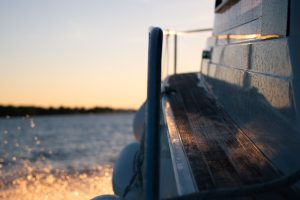Keeping boats stable with wireless telemetry

How remote monitoring is used to track centre of gravity and load distribution during boat construction
According to Fortune Business Insights, the global luxury yacht market size is projected to grow from $7.67 billion in 2023 to $13.67 billion by 2030. With more vessels being built to meet demand, it’s important that all aspects of the construction phase are streamlined, while balancing speed with safety. Here, Matthew Youngs, sales and marketing manager at telemetry specialist Mantracourt, discusses the significance of centre of gravity and load distribution during the construction phase and how wireless telemetry can improve the way this data is captured.
Perfectly balanced
In the context of boat building, the centre of gravity signifies the point of the boat where its mass is concentrated, while load distribution refers to the equitable apportionment of weight across the vessel. These two factors hold critical significance as they directly influence the boat’s stability, buoyancy and handling characteristics in the water.
A boat with an improperly positioned centre of gravity or uneven load distribution may experience instability, risking capsizing or erratic behaviour. Hence, monitoring these parameters during construction is critical.
 Before the advent of digital weighing systems, boat builders relied on rudimentary methods to estimate the centre of gravity and load distribution. Trial and error played a significant role, with builders launching boats and observing their performance in water. Waterline marks on the hull, simple balance techniques and observations of how the vessel floated were key tools. These methods were practical but lacked precision.
Before the advent of digital weighing systems, boat builders relied on rudimentary methods to estimate the centre of gravity and load distribution. Trial and error played a significant role, with builders launching boats and observing their performance in water. Waterline marks on the hull, simple balance techniques and observations of how the vessel floated were key tools. These methods were practical but lacked precision.
As boat construction became more structured, mathematical calculations and stability curves were introduced. Manual calculations considered elements like keel placement and centre of buoyancy. These methods added a level of precision but were reliant on accurate design and measurements.
Today, precise, real-time measurements can be taken using load cells, significantly streamlining the process by eliminating the need to launch the boats to see if the calculations are correct.
Many maritime regulations, like those outlined on the UK Government website, impose specific stability and safety standards for boats. By rigorously monitoring centre of gravity and load distribution, boat builders can ensure compliance, preventing legal complications.
Remote monitoring
Traditional digital monitoring systems often required the installation of connecting cables near the hull, which not only posed logistical challenges but also safety hazards. Wireless technology eliminates this need, streamlining the setup process.
Wireless systems provide real-time data, allowing boat builders to continuously track centre of gravity and load distribution during construction. This instant feedback enables timely adjustments and ensures precision.
Two primary wireless monitoring setups are prevalent for centre of gravity and load distribution in boat construction.
For a small setup, like vessels under 25 m, each load cell connects to its own transmitter, such as a T24, which transmits data to a radio receiver. The receiver subsequently links via USB to a PC. Using a free downloadable software, the PC processes and stores the data, enabling real-time monitoring and analysis.
For larger construction projects, the setup can be used with gateways, which also connect to a PC. This setup still involves connecting each load cell to a wireless transmitter, however, the signals from multiple load cells are then routed to strategically positioned gateway receivers across the site. These gateway receivers connect to a PC via USB, where data is meticulously processed. This configuration ensures comprehensive wireless signal coverage throughout the construction site.
Wireless technology has played a pivotal role in revolutionising this aspect, offering precision, convenience and efficiency. As the maritime industry continues to adopt wireless advancements, the future of boat construction appears promising, ensuring vessels that are not only safer but also more efficient and agile on the open waters.
Wireless telemetry systems are already being used in this industry. Nonis, an Italian weighing solutions provider, uses Mantracourt’s T24 along with R10X load cells, SILOKIT-RX Mounting kits to provide accurate centre of gravity and load distribution monitoring for the boat construction industry.
You can find out more about the processes involved in load monitoring for boats with Nonis’ case study. You can also see how the T24 can help you to remotely monitor sensors for applications in your industry by visiting www.mantracourt.com.











